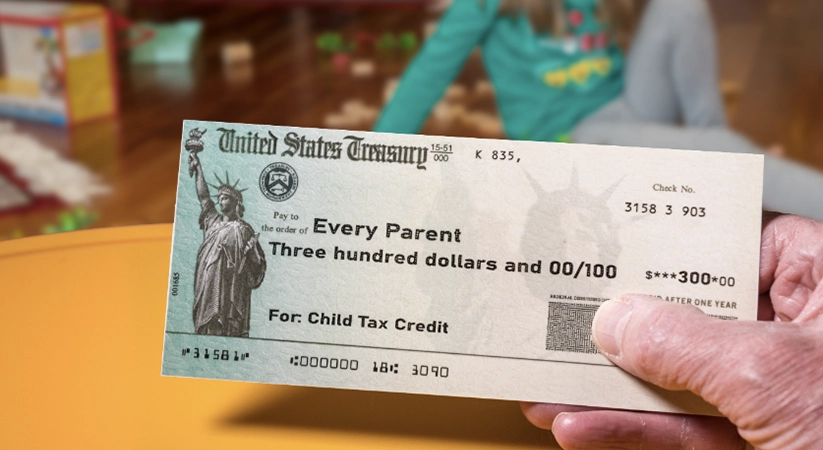
If you’re looking for a “payment schedule” to your child credit, well, the good news is there still is a child tax credit.
The Child Tax Credit is a tax benefit that provides financial support to families with children under the age of 18. It’s a tax benefit that helps offset the cost of raising a dependent. Eligible taxpayers receive a tax credit of up to $2,000 per child under age 17.
The CTC was expanded under the American Rescue Plan Act of 2021, and eligible families can receive monthly payments of up to $300 per child under 6 years of age and up to $250 per child aged 6-17.
However, those monthly payments have been discontinued, and the CTC has returned to its pre-pandemic scope and availability as an annual tax credit.
To help families plan their finances, the IRS released a schedule for Child Tax Credit payments that outlines when payments will be issued, how much families can expect to receive, and what actions they need to take to ensure they receive their payments.
What Was the Monthly Payment Schedule for Child Tax Credit payments?
Monthly installments of this tax credit were sent (by mail or direct deposit) to eligible taxpayers from July until December. The monthly payments varied, but tax payers received a maximum credit of $3,000 per eligible child ages 6 to 17 annually, and up to $3,600 for children under age 6 annually. (The amount of the credit phased out for taxpayers with adjusted gross incomes over $75,000 for single filers, $112,500 for head of household filers, and $150,000 for those filing a joint return.)
The payment schedule for child tax credit payments looked like this:
- July 15
- August 13
- September 15
- October 15
- November 15
- December 15
The Internal Revenue Service (IRS) sent the payments automatically to eligible taxpayers who filed a 2019 or 2020 income tax return or who used the non-filers tool on the IRS website to sign up for the stimulus payments the year before. Taxpayers didn’t file an income tax return could use the simplified tool on the IRS website to provide their information and receive the payments.
The advance payments stopped, and the child tax credit has returned to its pre-pandemic levels. The CTC is now an income tax credit that families could see on their tax refund.
How much is the Child Tax Credit for 2023 tax year?
The Child Tax Credit (CTC) is a refundable credit, which means that it is available even to parents who do not have any federal income tax liability. Child tax credit can be easy to calculate. However, don’t assuming the tax benefit is the same as it was.
For taxes filed in 2023 and afterward, you can only claim benefits of $2,000 for every child under 17 years old.
The tax credit was temporarily raised in the 2021 tax year (which was filed in 2022). It boosted to $3,600 for children 5 years old and under and $3,000 for children between 6-17 years old. Now, the CTC returned to pre-pandemic levels and monthly payments were discontinued. This means that the maximum possible credit is now set at $2,000 per child, with families required to have at least $3,000 in earned income in order to claim any part of the refund. Those who earn more can receive a refund worth 15 percent of the income above this threshold and up to a maximum of $1,500 for each qualified child.
Advance Monthly Payments No Longer
The temporary increase of the child tax credit included an option for advance payments; however, that advance payment schedule is no longer valid.
The child credit is now an annual income tax credit only, available through a single payment when you finish your business at the end of the tax season. While the child credit definitely offsets any tax liability you may face, it’s also possible you’ll receive that money in a direct deposit (if that’s how you requested to receive your tax refund.) However, direct deposits on a monthly basis are a thing of the past.
The Schedule 8812 Form Still Required
If you want to claim the Child Tax Credit, it’s important to know about the Schedule 8812 form. This form is used to determine your eligibility for the credit and how much you are entitled to. It is a critical component of claiming this benefit, so understanding how it works and how to fill it out properly is essential.
Eligibility Criteria for Child Tax Credit
Not all taxpayers are eligible to receive the tax credit.
To qualify, taxpayers had to meet certain requirements based on income, residency, and the age of their children. Firstly, the dependent had to be under the age of 17 as of December 31st of the tax year for which they claimed the credit. If the dependent turned 17 before this date, they would no longer eligible for the credit.
Secondly, the child had to be claimed as a dependent on your federal income tax return. They couldn’t provide more than half of their own support and must have lived with you for more than half of the tax year. Also, the In addition to the above requirements, the child must also be related to you in one of the following ways: as a son, daughter, stepchild, foster child, brother, sister, stepbrother, stepsister or a descendant of any of these.
Income Limitations
The Child Tax Credit payment schedule is a valuable benefit for eligible taxpayers with qualifying children. However, income limitations do apply to the credit, which means that not all taxpayers may be able to claim the maximum credit amount.
Currently, the income threshold for receiving the credit is $2,000 per child. This means that taxpayers may receive up to $2,000 per qualifying child as a credit against their federal income tax liability.
However, the credit begins to phase out for higher income levels. For married couples filing jointly, the phase-out begins at $400,000 of modified adjusted gross income (MAGI). For single filers and those filing as head of household, the phase-out begins at $200,000 of MAGI.
Taxpayers in Puerto Rico also have specific rules regarding the Child Tax Credit. For tax years 2021 and 2022, taxpayers in Puerto Rico who have three or more qualifying children may be eligible for a higher credit amount of up to $1,000 per child.
In addition to income limitations, there may be additional tax documents required to determine eligibility for the credit. For example, taxpayers may need to provide documentation to prove that their child meets the criteria for being a qualifying child, such as proof of the child’s age and relationship to the taxpayer.
Filing Status Requirements
When it comes to qualifying for the Child Tax Credit, the filing status requirements play an important role. The IRS offers five different filing statuses: single, married filing jointly, married filing separately, head of household, and qualifying widower with dependent child. Each filing status comes with its own eligibility requirements, which can affect the amount of the Child Tax Credit you can receive.
Single filing status is for individuals who aren’t married and don’t qualify for any other filing status. To qualify for the Child Tax Credit payments, a single filer must have a dependent child under the age of 17 and meet the income limitations set by the IRS.
Married filing jointly status is for couples who are legally married and want to file a single tax return together. To qualify for the Child Tax Credit, both spouses must have a valid Social Security number and a qualifying child. The couple must also meet the income limitations set by the IRS.
Married filing separately status is for couples who choose to file their taxes separately. To qualify for the Child Tax Credit, both spouses must have a valid Social Security number and an eligible child. However, the income limitations are significantly lower for this filing status, which may limit the amount of credit a taxpayer can receive.
Head of household status is for individuals who are unmarried but have a qualifying dependent, such as a child or elderly parent, living in their household. To qualify for the Child Tax Credit as head of household, the taxpayer must provide at least 50% of the financial support for their qualifying dependent and meet the income limitations set by the IRS.
Qualifying widower with dependent child status is for taxpayers who are widowed and have a dependent child. To qualify for the Child Tax Credit, the taxpayer must have a qualifying dependent, be claiming the dependent as their own, and meet the income limitations set by the IRS.

Sarah Nieschalk
Sarah E. Deierlein Nieschalk, EA, is an experienced tax professional with over a decade of expertise representing taxpayers before the IRS. As an Enrolled Agent and Assistant Vice President of Servicing at Community Tax, LLC, Sarah specializes in resolving complex federal and state tax collection issues, including high-dollar individual liabilities, employment tax challenges, and corporate audits. Since becoming an Enrolled Agent in 2012, she has resolved over 5,000 cases, saving millions for clients while protecting countless businesses. Outside of work, Sarah enjoys painting, staying active, and raising her family of rescued dogs while contributing to nonprofit causes through storytelling events.







